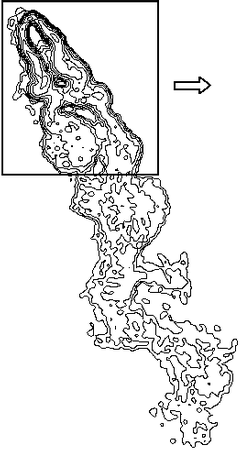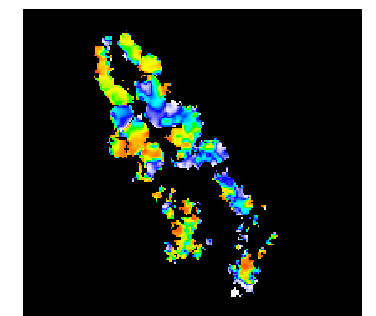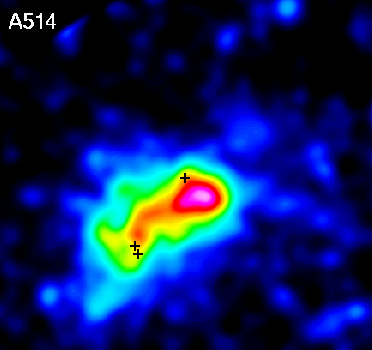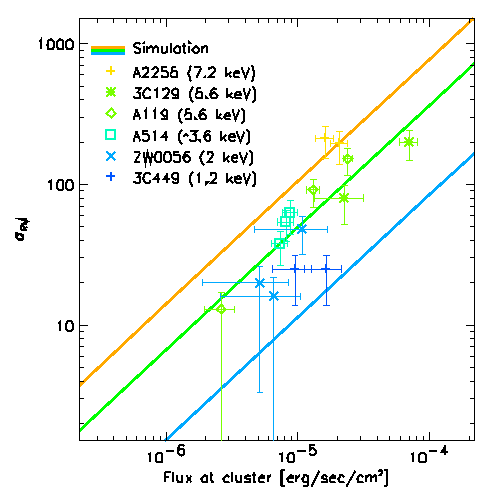| An Obscure Ingredient of Galaxy Clusters |
|
Galaxy clusters are the biggest, gravitational bound objects in the Universe, showing up as a concentration of galaxies on the sky. But the stars we see in these galaxies make only 1% of their mass. Approximate 90% of their mass consists of the so called dark matter. The rest is a hot gas component filling the space between the galaxies within these objects.
It is now well established that this hot inter cluster gas is also magnetized. This magnetic field cannot be seen directly, but it imprints a so called Faraday Rotation on the observations of radio galaxies seen through the cluster. An additional minor component of galaxy clusters, -- very hot particles, the so called cosmic rays -- illuminate the magnetic field within the galaxy cluster and make them appear as diffuse object when observed with radio telescopes.
| Figure 1: The imprint of Faraday Rotation by the magnetic field of galaxy cluster A119 on the Radio Galaxy 0053-016. | ||
|---|---|---|
 |
  L. Feretti, F. Govoni, IRB |
|
| The left panel shows a radio image of the radio galaxy 0053-016 observed at a frequency of 1.4GHz. Comparing the images obtained at different frequencies once can obtain the so called Faraday Rotation as shown in the right panel. The intensive red and white white patches in this map indicate the strengths of the magnetic field within the galaxy cluster A119, where the galaxy 0053-0016 is seen through. | ||
So far, the knowledge on the role of the magnetic fields in galaxy clusters was very limited. Therefore scientist at the Max Planck Institute for Astrophysics carried out simulations on the evolution and behavior of magnetic field within these cosmological objects. The simulations showed, that the process of large scale structure formation in the universe drives the characteristics of these magnetic fields. One of these results is that the magnetic field will be distributed in the same way as the gas density within galaxy clusters.
To take advantage of new upcoming measurements scientists at the Max Planck Institute for Astrophysics together with radio astronomers at the Istituto di Radioastronomia CNR in Bologna and x-ray astronomers at the John Moores University in Liverpool developed a new method for a more direct way to understand of the magnetic fields within galaxy clusters. Therefore both, the x-ray observations and the observation of Faraday Rotation are combined for a set of galaxy clusters.
| Figure 2: X-Ray image of galaxy cluster A514 with positions of radio galaxies where Faraday Rotation is measured. | ||
|---|---|---|
 S. Schindler, JMU |
||
| The image shows a false color representation of the galaxy cluster A514 as observed with an X-Ray telescope. These X-Rays are emitted by the hot gas within the galaxy cluster. The black crosses mark the position where radio galaxies with measured Faraday Rotation are located. | ||
All this data points are collected in Figure 3, where the X-Ray flux is plotted along the x-axis, and the Faraday Rotation is plotted along the y-axis. The comparison of these two measurements is chosen, because from this combination the relation between the magnetic field and the gas density within the galaxy cluster can be calculated.
These measurements show that, as predicted by the simulations, the strength of the magnetic field at any point within galaxy clusters is proportional to the gas density. The simulations predict that this relations will shift with the temperature of the cluster -- which is an indication of the total mass of a galaxy cluster -- which is also nicely verified by these measurements.
| Figure 3: Comparison of X-Ray flux and measured Faraday Rotation for a collection of clusters. | ||
|---|---|---|
 |
||
| This plot shows a comparison of X-Ray flux and measured Faraday Rotation for a collection of clusters, and a comparison with theoretical predictions. The data points are marked with different colors according to the individual cluster temperature. Theoretical predictions are shown as lines for three temperatures. Data points for different sources in the same cluster follow very well the predicted lines. The simulations also predict these lines to be shifted according to the temperature of the cluster. This trend is also confirmed by the data points. | ||
It is a long ongoing debate within the scientific community, whether the magnetic field influence the dynamics of galaxy clusters or not. The answer to this question is important, because once would like to learn more about the dark matter by studying these objects. Unfortunately, one only can observe the stars and the intra-cluster gas, therefore the conclusions on unseen dark matter depend on our correct understanding of the physical processes. This new results cannot give a definitive answer to this question, but is a step forward in the understanding of this obscure ingredient in galaxy clusters. They also show that the theoretical modeling -- by simulating these processes -- is already advanced enough to predict details in the observations.
Furthermore this combination of simulations and observations provides a good framework when one wants to understand features in the X-ray observations of galaxy clusters, which have been obtained by the new generation of X-Ray telescopes. They clearly show that some extra physics -- most likely magnetic fields -- play a crucial role in phenomena observed in some galaxy clusters like cooling flows or the detection of sharp edges within the clusters, where thermal conduction has to be suppressed.